light DATSUN 210 1979 Repair Manual
[x] Cancel search | Manufacturer: DATSUN, Model Year: 1979, Model line: 210, Model: DATSUN 210 1979Pages: 548, PDF Size: 28.66 MB
Page 363 of 548

6
Apply
P
B
C
grease
to
yoke
slid
ing
part
of
cylinder
Then
reposition
bias
ring
so
that
groove
of
bias
ring
coincides
with
yoke
7
Leaving
yoke
springs
inserted
lightly
into
cylinder
groove
assemble
cylinder
body
and
yoke
by
pushing
or
tapping
yoke
lightly
BA570
Fig
BR
19
A
embling
Yoke
and
Cylinder
8
Install
air
bleeder
valve
on
caliper
INSTAlLATION
1
Install
in
reverse
procedure
of
removal
CAUTION
When
installing
brake
tube
use
Flare
Nut
Torque
Wrench
6694310000
fJ
Tightening
tOlque
Calipel
securing
bolts
4
6
to
6
1
kll
m
33
to
44
ft
lb
Brake
tube
flere
nuts
1
5to
1
8
kg
m
11
to
13
ft
Ib
2
After
installing
pad
bleed
air
from
system
Brake
System
ROTOR
REMOVAL
Refer
to
Front
Axle
Section
FA
for
removal
Note
As
this
value
increases
wear
occurs
progressively
vibration
cor
responding
to
revolution
of
tire
may
often
be
tmnsmitted
to
in
terior
of
car
INSPECTION
Check
the
following
items
and
if
necessary
replace
Checks
can
be
made
by
removing
only
wheel
Sliding
surface
If
there
are
cracks
or
considerable
chips
replace
2
Runout
Adjust
wheel
bearing
correctly
Using
a
dial
gauge
measure
runout
at
the
center
of
rotor
pad
contact
sur
face
Runout
limit
less
than
0
12
mm
0
0047
in
Total
indicator
reading
BR025A
Fig
BR
20
Mecuuring
Runout
3
Parallelism
Measure
thickness
of
entire
periph
cry
of
rotor
using
a
micrometer
Parallelism
when
new
less
than
0
03
mm
0
0012
in
BR
9
Fig
BR
21
Measuring
Parallelism
4
Thickness
If
rotor
thickness
is
beyond
wear
limit
replace
rotor
When
correcting
thickness
be
sure
that
the
thickness
after
correction
does
not
exceed
the
limit
Standard
thickness
10
0
mm
0
394
in
Wear
limit
more
than
8
4
mm
0
331
in
INSTALLATION
Install
rotor
in
reverse
order
of
removal
Adjust
wheel
bearing
preload
correctly
Refer
to
Front
Axle
Sec
tion
FA
for
adjustment
ifl
Tightening
torque
Rotor
to
wheel
hub
3
9
to
5
3
kg
m
28
to
38
ft
rb
Page 369 of 548
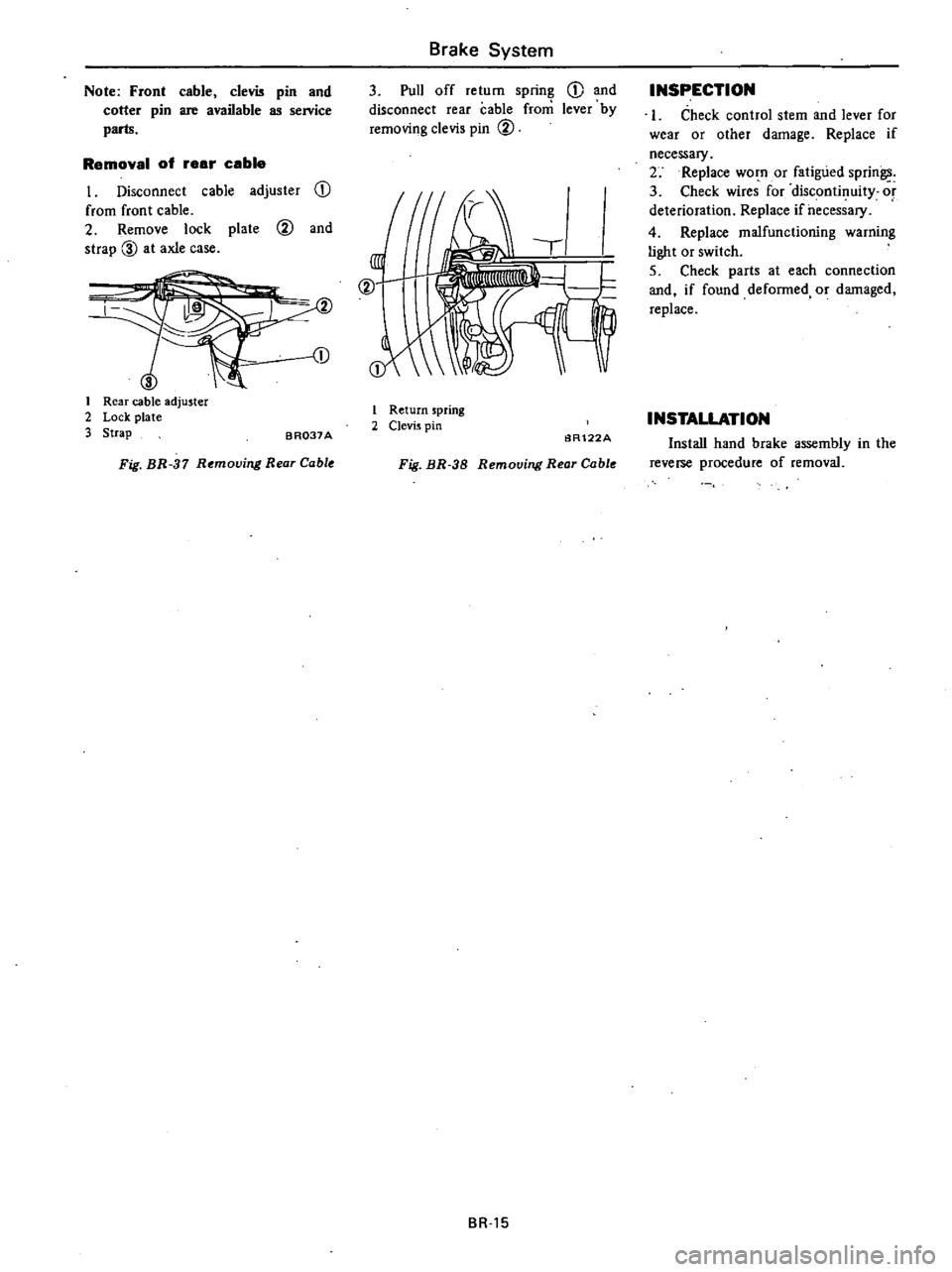
Note
Front
cable
clevis
pin
and
cotter
pin
are
available
as
service
parts
Removal
of
eer
ceble
I
Disconnect
cable
adjuster
CD
from
front
cable
2
Remove
lock
plate
@
and
strap
00
at
axle
case
1
I
Rear
cable
adjuster
2
Lock
plate
3
Strap
BR037A
Fig
BR
37
Removing
Rear
Cable
Brake
System
3
Pull
off
return
spring
CD
and
disconnect
rear
cable
from
lever
by
removing
clevis
pin
@
@
I
Return
spring
2
Clevis
pin
6R122A
Fig
BR
38
Removing
Rear
Cable
BR
15
INSPECTION
I
Check
control
stem
and
lever
for
wear
or
other
damage
Replace
if
necessary
2
Replace
worn
or
fatigued
sprin
3
Check
wires
for
discontinuity
or
deterioration
Replace
ifheces
ary
4
Replace
malfunctioning
warning
light
or
switch
5
Check
parts
at
each
connection
and
if
found
defonned
or
damaged
replace
INSTALLATION
Install
hand
brake
assembly
in
the
reverse
procedure
of
removal
Page 375 of 548
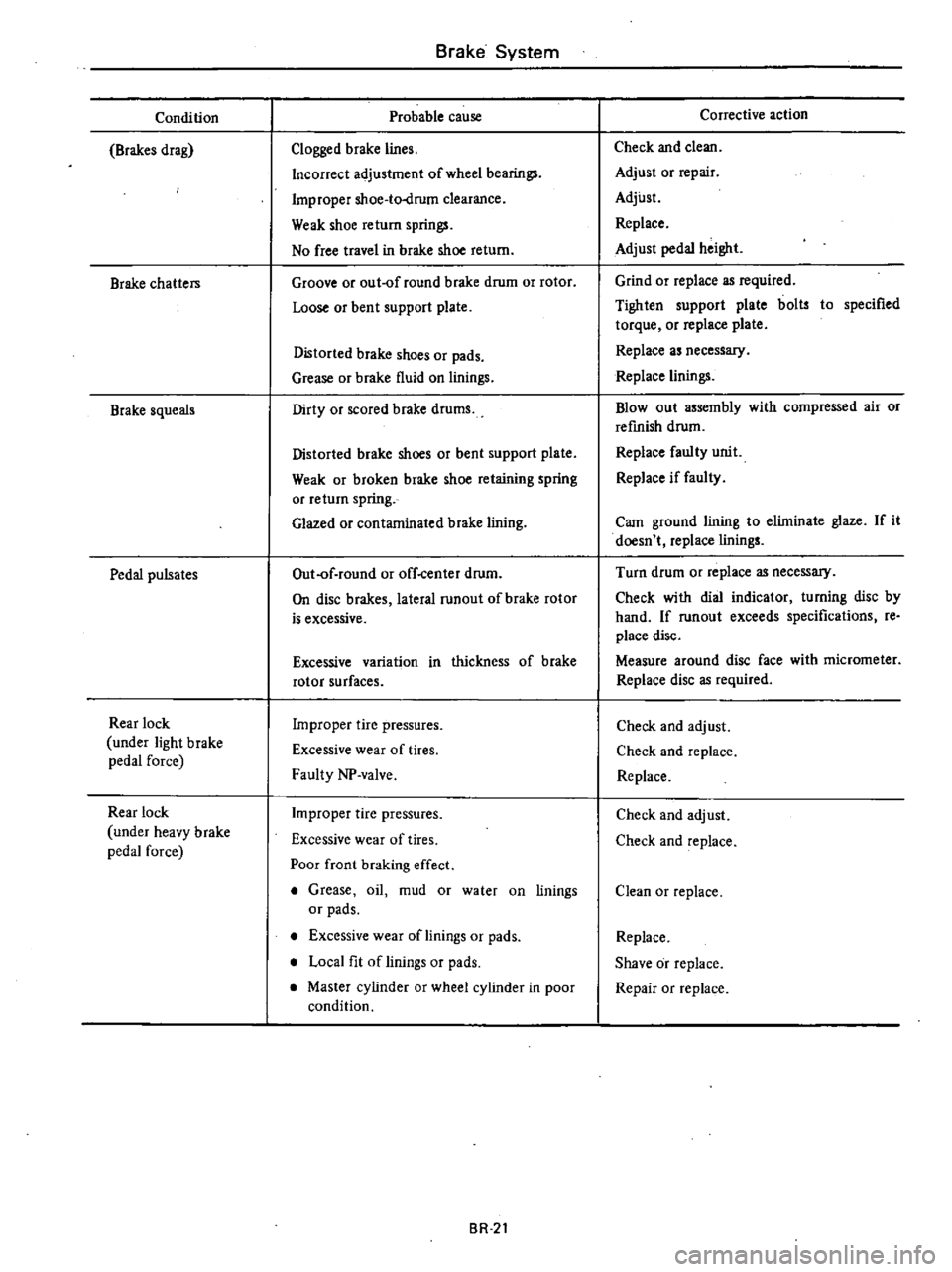
Condition
Brakes
drag
Brake
chatters
Brake
squeals
Pedal
pulsates
Rear
lock
under
light
brake
pedal
force
Rear
lock
under
heavy
brake
pedal
force
Brake
System
Probable
cause
Clogged
brake
lines
Incorrect
adjustment
of
wheel
bearings
Improper
shoe
to
drum
clearance
Weak
shoe
return
springs
No
free
travel
in
brake
shoe
return
Groove
or
out
of
round
brake
drum
or
rotor
Loose
or
bent
support
plate
Distorted
brake
shoes
or
pads
Grease
or
brake
fluid
on
linings
Dirty
or
scored
brake
drums
Distorted
brake
shoes
or
bent
support
plate
Weak
or
broken
brake
shoe
retaining
spring
or
return
spring
Glazed
or
contaminated
brake
lining
Out
of
round
or
off
center
drum
On
disc
brakes
lateral
runout
of
brake
rotor
is
excessive
Excessive
variation
in
thickness
of
brake
rotor
surfaces
Improper
tire
pressures
Excessive
wear
of
tires
Faulty
NP
valve
Improper
tire
pressures
Excessive
wear
of
tires
Poor
front
braking
effect
Grease
oil
mud
or
water
on
linings
or
pads
Excessive
wear
of
linings
or
pads
Local
fit
of
linings
or
pads
Master
cylinder
or
wheel
cylinder
in
poor
condition
BR
2t
Corrective
action
Check
and
clean
Adjust
or
repair
Adjust
Replace
Adjust
pedal
height
Grind
or
replace
as
required
Tighten
support
plate
bolts
to
specified
torque
or
replace
plate
Replace
as
necessary
Replace
linings
Blowout
assembly
with
compressed
air
or
refinish
drum
Replace
faulty
unit
Replace
if
faulty
Cam
ground
lining
to
elilninate
glaze
If
it
doesn
t
replace
linings
Turn
drum
or
replace
as
necessary
Check
with
dial
indicator
turning
disc
by
hand
If
runout
exceeds
specifications
re
place
disc
Measure
around
disc
face
with
micrometer
Replace
disc
as
required
Check
and
adjust
Check
and
replace
Replace
Check
and
adjust
Check
and
replace
Clean
or
replace
Replace
Shave
or
replace
Repair
or
replace
Page 379 of 548
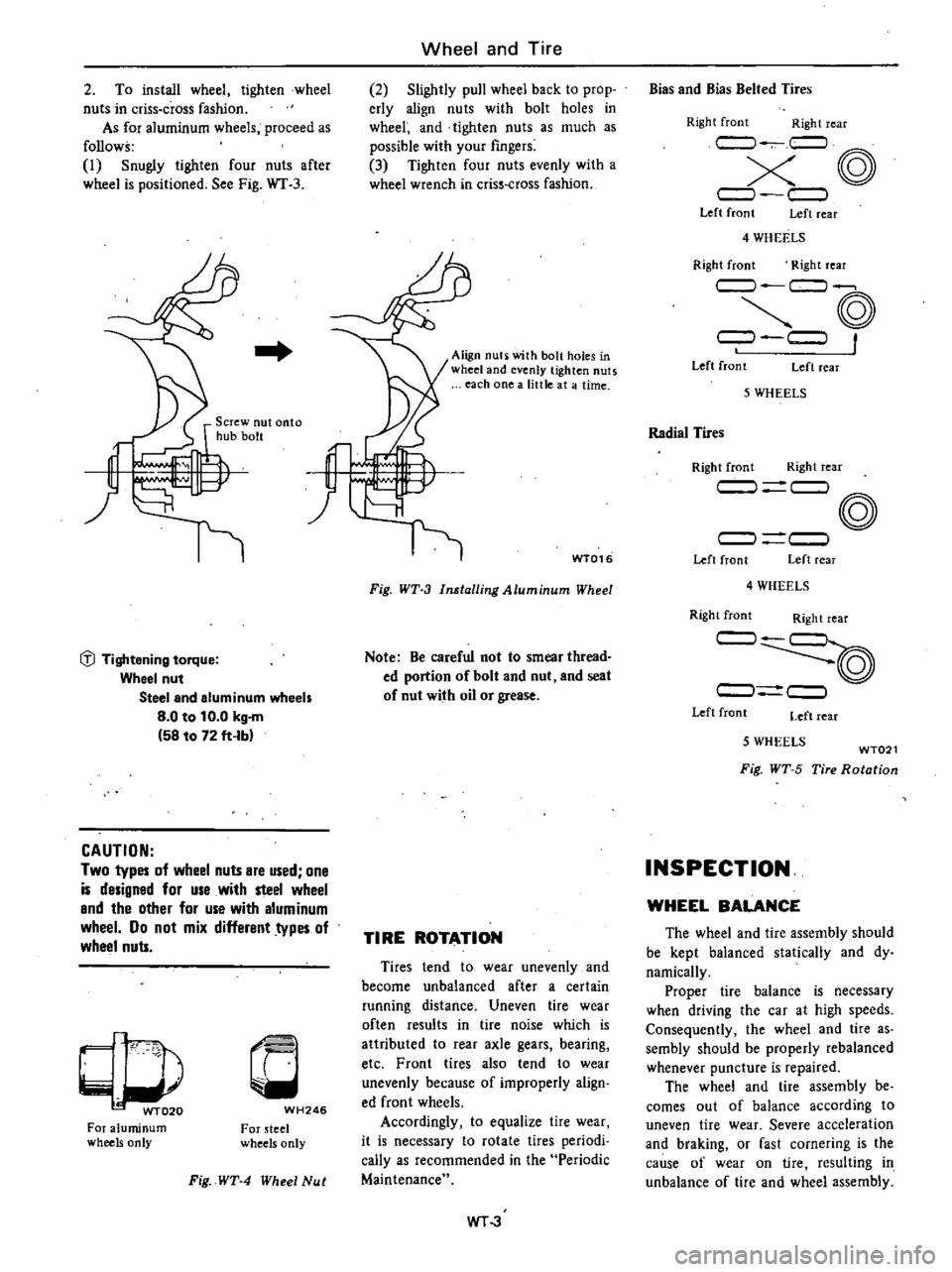
2
To
install
wheel
tighten
wheel
nuts
in
criss
cross
fashion
As
for
aluminum
wheels
proceed
as
follows
I
Snugly
tighten
four
nuts
after
wheel
is
positioned
See
Fig
WT
3
Iil
Tightening
torque
Wheel
nut
Steel
and
aluminum
wheels
8
0
to
10
0
kg
m
58
to
72
ft
Ibl
CAUTION
Two
types
of
wheel
nuts
Bre
used
one
is
designed
for
use
with
steel
wheel
Bnd
the
other
for
use
with
aluminum
wheel
Do
not
mix
different
types
of
wheel
nuts
p
WT020
For
aluminum
wheels
only
c
WH246
For
teel
wheels
only
Fig
WT
4
Wheel
Nut
Wheel
and
Tire
2
Slightly
pull
wheel
back
to
prop
erly
align
nuts
with
bolt
holes
in
wheel
and
tighten
nuts
as
much
as
possible
with
your
fingers
3
Tighten
four
nuts
evenly
with
a
wheel
wrench
in
criss
cross
fashion
f
WT016
Align
nuti
with
bolt
holes
in
wheel
and
evenly
tighten
nuts
each
one
a
little
at
a
time
Fig
WT
3
Installing
Aluminum
Wheel
Note
Be
careful
not
to
smear
thread
ed
portion
of
bolt
and
nut
and
seat
of
nut
with
oil
or
grease
TIRE
ROTATION
Tires
tend
to
wear
unevenly
and
become
unbalanced
after
a
certain
running
distance
Uneven
tire
wear
often
results
in
tire
noise
which
is
attributed
to
rear
axle
gears
bearing
etc
Front
tires
also
tend
to
wear
unevenly
because
of
improperly
align
ed
front
wheels
Accordingly
to
equalize
tire
wear
it
is
necessary
to
rotate
tires
periodi
cally
as
recommended
in
the
Periodic
Maintenance
WT
3
Bias
and
Bias
Belted
Tires
Right
front
Right
rear
c
J
c
l
X@
c
l
c
J
Left
front
Left
rear
4
WH
EELS
Right
front
Right
rear
c
J
c
l
@
9
c
J
Left
front
Left
rear
5
WHEELS
Radial
Tires
Right
front
Right
rear
c
J
c
l
@
c
l
c
J
Left
front
Left
rear
4
WHEELS
Right
front
Right
rear
c
J
c
J
c
l
Left
front
Left
rear
5
WHEELS
WT021
Fig
WT
5
Tire
Rotation
INSPECTION
WHEEL
BALANCE
The
wheel
and
tire
assembly
should
be
kept
balanced
statically
and
dy
namically
Proper
tire
balance
is
necessary
when
driving
the
car
at
high
speeds
Consequently
the
wheel
and
tire
as
sembly
should
be
properly
rebalanced
whenever
puncture
is
repaired
The
wheel
and
tire
assembly
be
comes
out
of
balance
according
to
uneven
tire
wear
Severe
acceleration
and
braking
or
fast
cornering
is
the
cause
of
wear
on
tire
resulting
in
unbalance
of
tire
and
wheel
assembly
Page 388 of 548
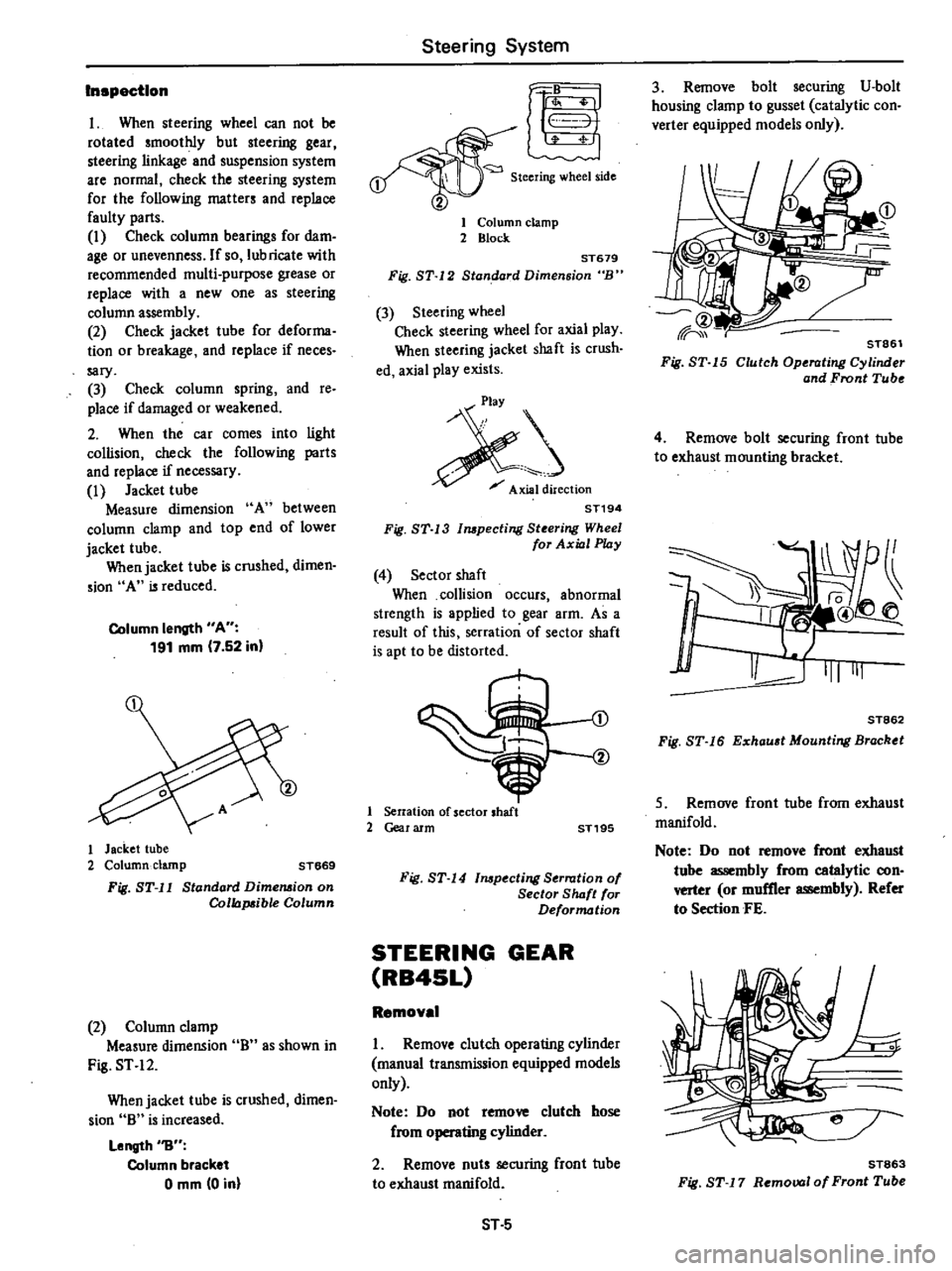
Inspection
I
When
steering
wheel
can
not
be
rotated
smoothly
but
steering
gear
steering
linkage
and
suspension
system
are
normal
check
the
steering
system
for
the
following
matters
and
replace
faulty
parts
I
Check
column
bearings
for
dam
age
or
unevenness
If
so
lubricate
with
recommended
multi
purpose
grease
or
replace
with
a
new
one
as
steering
column
assembly
2
Check
jacket
tube
for
deforma
tion
or
breakage
and
replace
if
neces
sary
3
Check
column
spring
and
re
place
if
damaged
or
weakened
2
When
the
car
comes
into
light
collision
check
the
following
parts
and
replace
if
necessary
I
Jacket
tube
Measure
dimension
A
between
column
clamp
and
top
end
of
lower
jacket
tube
When
jacket
tube
is
crushed
dimen
sion
A
is
reduced
Column
length
A
191
mm
7
52
in
1
Jacket
tube
2
Column
clamp
ST669
Fig
ST
l1
Standard
Dimension
on
Collapsible
Column
2
Column
clamp
Measure
dimension
0
as
shown
in
Fig
ST
12
When
jacket
tube
is
crushed
dimen
sion
0
is
increased
Length
1J
Column
bracket
o
mm
0
in
Steering
System
r
1
Steering
wheel
side
1
Column
clamp
2
Block
ST679
Fig
ST
12
Standard
Dimension
B
3
Steering
wheel
Check
steering
wheel
for
axial
play
When
steering
jacket
shaft
is
crush
ed
axial
play
exists
j
Axial
direction
ST194
Fig
ST
13
mpecting
Steering
Wheel
for
Axial
Play
4
Sector
shaft
When
collision
occurs
abnormal
strength
is
applied
to
gear
arm
As
a
result
of
this
serration
of
sector
shaft
is
apt
to
be
distorted
1
Serration
of
sector
shaft
2
Gear
arm
ST195
Fig
ST
14
mpeeting
Serration
of
Sector
S
IuJft
for
Deformation
STEERING
GEAR
RB4SL
Removal
I
Remove
clutch
operating
cylinder
manual
transmission
equipped
models
only
Note
Do
not
remove
clutch
hose
from
8
cylinder
2
Remove
nuts
securing
front
tube
to
exhaust
manifold
ST
5
3
Remove
bolt
securing
V
bolt
housing
clamp
to
gusset
catalytic
con
verter
equipped
models
only
STa6l
Fig
ST
5
Clutch
Operating
Cylinder
and
Front
Tube
4
Remove
bolt
securing
front
tube
to
exhaust
mounting
bracket
1
Q
I
II
@
J
111111
ST862
Fig
ST
16
Exhau
t
Mounting
Bracktt
5
Remove
front
tube
from
exhaust
manifold
Note
Do
not
remove
front
exhaust
tube
assembly
from
catalytic
con
verter
or
muffler
assembly
Refer
to
Section
FE
ST863
Fig
ST
7
Removal
of
Front
Tube
Page 391 of 548
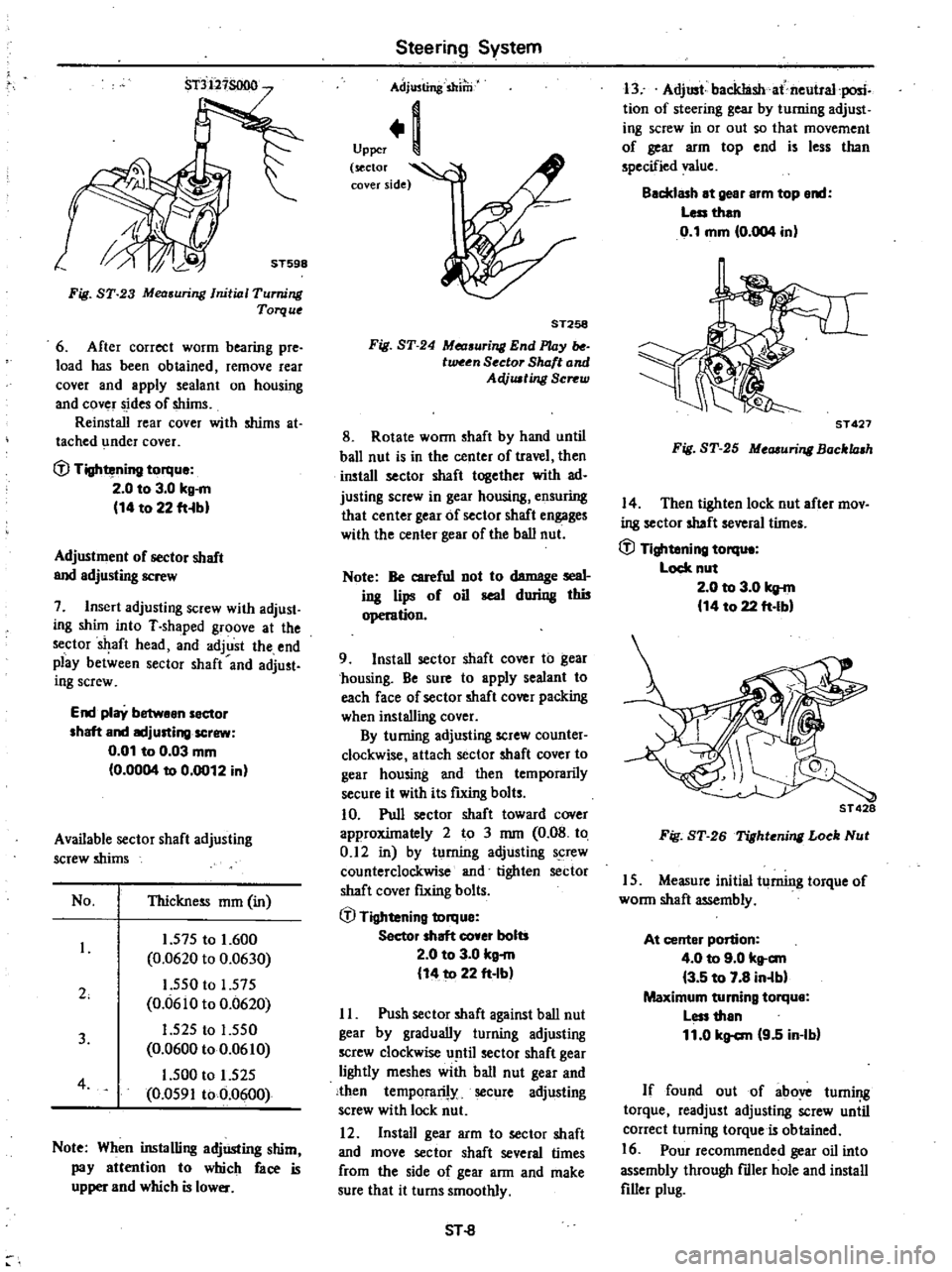
Fig
ST
23
Mea
uring
Initial
Turning
Torque
6
After
correct
worm
bearing
pre
load
has
been
obtained
remove
rear
cover
and
apply
sealant
on
housing
and
cover
sides
of
shims
Reinstall
rear
cover
with
shims
at
tached
under
cover
fJ
Tightening
torque
2
0
to
3
0
kg
m
14
to
22
fHbl
Adjustment
of
sector
shaft
and
adjusting
screw
7
Insert
adjusting
screw
with
adjust
ing
shUn
into
T
shaped
groove
at
the
sector
aft
head
and
adjust
the
end
play
between
sector
shaft
and
adjust
ing
screw
End
play
betwean
sector
shaft
and
IKljusting
screw
0
01
to
0
03
mm
0
0004
to
0
0012
in
Available
sector
shaft
adjusting
screw
shims
No
Thickness
mm
in
2
1
575
to
1
600
0
0620
to
0
0630
1
550
to
1
575
0
0610
to
0
0620
1
525
to
1
550
0
0600
to
0
0610
1
500
to
1
525
0
0591
to
0
0600
3
4
Note
When
installing
adjUsting
shim
pay
attention
to
which
face
is
upper
and
which
is
lower
Steering
System
Adjusting
shilli
Upper
1
sector
l
cover
side
ST258
Fig
ST
24
Measuri
End
l
UJy
tween
Sector
Shaft
and
AeVusting
Screw
8
Rotate
wonn
shaft
by
hand
until
ball
nut
is
in
the
center
of
travel
then
install
sector
shaft
together
with
ad
justing
screw
in
gear
housing
ensuring
that
center
gear
of
sector
shaft
engages
with
the
center
gear
of
the
ball
nut
Note
Be
careful
not
to
damage
seal
ing
lips
of
oil
seal
during
thi5
operation
9
Install
sector
shaft
cover
to
gear
chousing
Be
sure
to
apply
sealant
to
each
face
of
sector
shaft
cover
packing
when
installing
cover
By
turning
adjusting
screw
counter
clockwise
attach
sector
shaft
cover
to
gear
housing
and
then
temporarily
secure
it
with
its
futing
bolts
10
Pull
sector
shaft
toward
cover
approxUnately
2
to
3
mm
0
08
to
0
12
in
by
turning
adjusting
screw
counterclockwise
and
tighten
sector
shaft
cover
fIXing
bolts
fJ
Tightening
torque
Sector
shaft
co
er
bolts
2
0
to
3
0
kg
m
14
to
22
ft
Ib
II
Push
sector
shaft
against
ball
nut
gear
by
gradually
turning
adjusting
screw
clockwise
until
sector
shaft
gear
lightly
meshes
with
ball
nut
gear
and
then
temporarily
secure
adjusting
screw
with
lock
nut
12
Install
gear
arm
to
sector
shaft
and
move
sector
shaft
several
times
from
the
side
of
gear
ann
and
make
sure
that
it
turns
smoothly
SHl
13
Adjust
backIashat
neutral
posic
tion
of
steering
gear
by
turning
adjust
iog
screw
in
or
out
so
that
movement
of
gear
arm
top
end
is
less
than
specified
value
Backlash
at
gear
arm
top
end
Less
than
0
1
mm
0
004
in
ST
427
Fig
ST
25
Measuri
Bocklash
14
Then
tighten
lock
nut
after
mov
ing
sector
shaft
several
tUnes
fJ
Tightening
torqu
Lock
nut
2
0
to
3
0
kg
m
14
to
22
ft
Ibl
ST
428
Fig
ST
26
Tighteni
Loek
Nut
15
Measure
initial
turning
torque
of
wonn
shaft
assembly
At
center
portion
4
0
to
9
0
kt
c
m
3
5
to
7
8
in
lbl
Maximum
turning
torque
Less
than
11
0
kg
c
m
9
5
in
Ib
If
found
out
of
above
turning
torque
readjust
adjusting
screw
uniil
correct
turning
torque
is
obtained
16
Pour
recommended
gear
oil
into
assembly
through
fdler
hole
and
install
filler
plug
Page 407 of 548
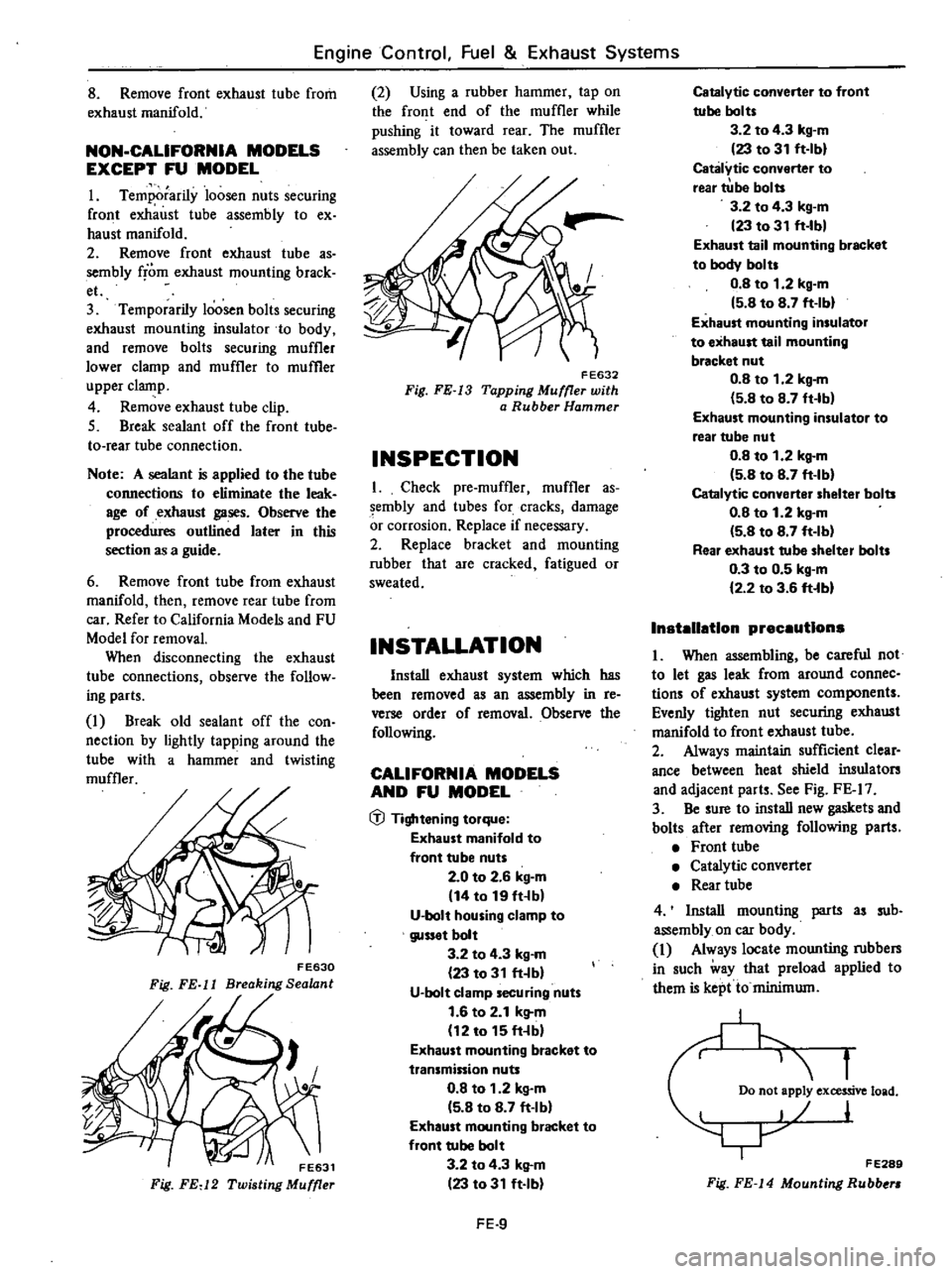
Engine
Control
Fuel
Exhaust
Systems
8
Remove
front
exhaust
tube
from
exhaust
manifold
NON
CALIFORNIA
MODELS
EXCEPT
FU
MODEL
I
Temporarily
loosen
nuts
securing
front
exhaust
tube
assembly
to
ex
haust
manifold
2
Remove
front
exhaust
tube
as
sembly
from
exhaust
mounting
brack
et
3
Temporarily
loosen
bolts
securing
exhaust
mounting
insulator
to
body
and
remove
bolts
securing
muffler
lower
clamp
and
muffler
to
muffler
upper
clamp
4
Remove
exhaust
tube
clip
5
Break
sealant
off
the
front
tube
to
rear
tube
connection
Note
A
sealant
is
applied
to
the
tube
connections
to
eliminate
the
leak
age
of
exhaust
gases
Observe
the
procedures
outlined
later
in
this
section
as
a
guide
6
Remove
front
tube
from
exhaust
manifold
then
remove
rear
tube
from
car
Refer
to
California
Models
and
FU
Model
for
removal
When
disconnecting
the
exhaust
tube
connections
observe
the
follow
ing
parts
I
Break
old
sealant
off
the
con
nection
by
lightly
tapping
around
the
tube
with
a
hammer
and
twisting
muffler
F
E630
Fig
FE
11
Breaking
Sealant
Fig
FEd
2
2
Using
a
rubber
hammer
tap
on
the
front
end
of
the
muffler
while
pushing
it
toward
rear
The
muffler
assembly
can
then
be
taken
out
FE632
Fig
FE
13
Tapping
Muffler
with
a
Rubber
Hammer
INSPECTION
I
Check
pre
muffler
muffler
as
sembly
and
tubes
for
cracks
damage
or
corrosion
Replace
if
necessary
2
Replace
bracket
and
mounting
rubber
that
are
cracked
fatigued
or
sweated
INSTALLATION
Install
exhaust
system
which
has
been
removed
as
an
assembly
in
re
verse
order
of
removal
Observe
the
following
CALIFORNIA
MODELS
AND
FU
MODEL
1Jl
Tightening
torque
Exhaust
manifold
to
front
tube
nuts
2
0
to
2
6
kg
m
14
to
19
fHb
U
bolt
housing
clamp
to
gusset
bolt
3
2
to
4
3
kg
m
23
to
31
ft
bl
U
bolt
clamp
securing
nuts
1
6
to
2
1
k
l
m
12
to
15
ft
bl
Exhaust
mounting
bracket
to
transmission
nuts
0
8
to
1
2
kg
m
5
8
to
8
7
ft
Ibl
Exhaust
mounting
bracket
to
front
tube
bolt
3
2
to
4
3
k
l
m
23
to
31
ft
Ib
FE
9
CatalytiC
converter
to
front
tube
bolts
3
2
to
4
3
kg
m
23
to
31
ft
Ibl
Catalytic
converter
to
rear
tUbe
bolts
3
2
to
4
3
kg
m
23
to
31
ft
Ibl
Exhaust
tail
mounting
bracket
to
body
bolts
0
8
to
1
2
kg
m
5
B
to
8
7
ft
Ibl
Exhaust
mounting
insulator
to
exhaust
tail
mounting
bracket
nut
0
8
to
1
2
kg
m
5
8
to
8
7
ft
Ib
Exhaust
mounting
insulator
to
rear
tube
nut
O
B
to
1
2
kg
m
5
8
to
8
7
ft
Ib
Catalytic
converter
shelter
bolts
O
B
to
1
2
kg
m
5
8
to
B
7
ft
Ib
Rear
exhaust
tube
shelter
bolts
0
3
to
0
5
kg
m
2
2
to
3
6
ft
bl
Installation
precautions
I
When
assembling
be
careful
not
to
let
gas
leak
from
around
connec
tions
of
exhaust
system
components
Evenly
tighten
nut
securing
exhaust
manifold
to
front
exhaust
tube
2
Always
maintain
sufficient
clear
ance
between
heat
shield
insulators
and
adjacent
parts
See
Fig
FE
I7
3
Be
sure
to
install
new
gaskets
and
bolts
after
removing
following
parts
Front
tube
Catalytic
converter
Rear
tube
4
Install
mounting
parts
as
sub
assembly
on
car
body
I
Always
locate
mounting
rubbers
in
such
way
that
preload
applied
to
them
is
kept
to
minimum
f
Do
not
apply
excessive
load
I
F
E289
Fig
FE
J4
Mounting
Rubbe
Page 441 of 548

CLUSTER
I
IDA
Removal
and
installation
I
Disconnect
batterv
ground
cable
2
Remove
steering
column
cover
3
Remove
illumination
control
rhe
ostat
4
Pull
out
heater
control
knob
and
remove
heater
c
ntrol
finisher
5
Remove
screw
attaching
heater
control
assembly
to
cluster
lid
A
nQ
lQ
Ii
tl
rffmfLu
O
r
BF783B
Fig
BF
86
Removing
Screw
A
Uoching
Heater
Control
6
Pull
out
radio
dial
knobs
and
remove
nuts
and
washers
7
Draw
out
ash
tray
and
remove
screws
securing
ash
tray
holder
to
cluster
lid
A
B
Remove
cluster
lid
A
securing
screws
1
G808
iS
Ill
1
CJy
BF7848
Fig
BF
87
Remooing
Screw
Attaching
Cluster
Lid
A
CONSOLE
BOX
@
01
Automatic
control
2
Console
box
indicator
3
Console
box
bracket
Body
9
Disconnect
following
wire
harness
connectors
Ash
tray
illumination
Cigarette
lighter
Rear
defogger
switch
Warning
light
Clock
Turn
signal
switch
10
Remove
cluster
lid
A
drawing
it
out
backward
11
Installation
is
in
the
reverse
order
of
removal
CLUSTER
LID
B
Removal
and
Installation
I
Remove
instrument
lower
assist
cover
2
With
glove
box
lid
open
remove
lid
stopper
securing
screw
3
Remove
cluster
lid
B
securing
screws
i
i
ll
r
II
I
BF580B
Fig
BF
88
Removing
Cluster
Lid
B
4
Remove
cluster
lid
B
5
Installation
is
in
the
reverse
order
of
removal
J
BF581
B
Fig
BF
89
Console
Bo
SF
30
SEAT
FRONT
SEAT
Removal
and
installation
I
Remove
bolts
attaching
front
of
seat
bracket
to
floor
2
Remove
bolts
attaching
rear
of
seat
bracket
to
floor
3
Then
remove
front
seat
assembly
from
car
4
Installation
is
in
the
reverse
order
of
removal
REAR
SEAT
Removal
and
Installation
Sedan
I
Remove
bolts
attaching
rear
seat
cushion
front
end
and
remove
rear
seat
cushion
2
Remove
screws
attaching
rear
seat
back
and
lift
it
up
Then
remove
it
from
body
f
I
8F5828
Fig
BF
90
Removing
Rear
Seat
3
Installation
is
in
the
reverse
order
of
removaL
Hatchback
and
Wagon
I
Unfasten
screw
and
clip
retaining
luggage
floor
carpets
Page 443 of 548

INSPECTiON
OF
SEAT
BELT
SWITCH
The
contacts
of
seat
belt
switch
are
normally
closed
When
tongue
latches
buckle
the
tip
end
of
tongue
pushes
push
rod
to
open
the
switch
contacts
ROOF
TRIMMING
Removel
end
Inetelletlon
l
Remove
room
lamp
assist
grip
coat
hangers
inside
rearview
mirror
and
sun
visors
2
Remove
body
side
welts
and
re
move
roof
side
garnishes
and
tail
rail
garnish
3
Remove
rear
side
finishers
4
Draw
out
roof
headlining
from
windshield
weatherstrip
5
Installation
is
in
the
reverse
order
of
removal
Body
u
I
Disconnectbatter
y
ground
cable
2
Disconnect
seat
belt
switch
wire
harness
lape
belt
latches
buckle
and
go
on
when
it
unlatches
buckle
Replace
belt
assembly
if
necessary
Note
When
checking
seat
belt
switch
operation
make
sure
that
power
held
below
16
volts
and
13
mA
3
Check
seat
belt
switch
for
proper
operation
using
a
test
light
The
light
should
go
out
when
tongue
of
outer
TRIM
AND
MOLDING
f
BODY
SIDE
TRIM
AND
MOLDING
SEDAN
T
S
Tail
rail
1
J
clamp
2
Rear
side
finisher
3
Tailrail
garnish
4
Headlining
5
Roof
side
garnish
6
Coat
hanger
7
Assist
grip
8
Sun
visor
9
Inside
rearview
mirror
BF173B
Fig
BF
96
Roof
Trimming
1
Dash
side
finisher
2
Front
pillar
garnish
3
Body
front
side
welt
4
Center
pillar
garnish
5
Body
side
rear
welt
6
Rear
seat
back
finisher
7
Front
kicking
plate
8
Rear
kicking
plate
9
Drip
center
molding
10
Rear
comer
garnish
11
Air
outlet
grille
12
Front
pillar
molding
Fig
BF
97
Body
Side
Trim
ond
Molding
4
Door
BF783B
BF
32
Page 446 of 548

DATSUN
210
Model
8310
Series
SECTIONBE
BODY
ELECTRICAL
SYSTEM
CONTENTS
BODY
ELECTRICAL
WIRING
DESCRIPTION
FUSE
AND
FUSIBLE
LINK
WIRING
WIRING
HARNESS
LOCATION
OF
ELECTRICAL
UNIT
ELECTRICAL
UNIT
OF
LIGHTING
SYSTEM
BULB
SPECIFICATIONS
REMOVAL
AND
INSTALLATION
For
lamp
IGNITION
SWITCH
COMBINATION
SWITCH
ILLUMINATION
CONTROL
UNIT
AIMING
ADJUSTMENT
ELECTRICAL
UNIT
OF
SIGNAL
SYSTEM
BE
12
TURN
SIGNAL
SWITCH
BE
12
HORN
RELAY
BE
12
HAZARD
SWITCH
BE
12
STOP
LAMP
SWITCH
BE
12
BACK
UP
LAMP
SWITCH
BE
12
DOOR
SWITCH
BE
12
METERS
AND
GAUGES
BE
13
COMBINATION
METER
BE
13
TACHOMETER
BE
14
FUEL
LEVEL
AND
WATER
TEMPERATURE
INDICATOR
SYSTEM
BE
14
WARNING
SYSTEM
BE
15
CHARGE
WARNING
SYSTEM
BE
15
BRAKE
WARNING
SYSTEM
BE
15
BE
2
BE
2
BE
2
BE
4
BE
5
BE
8
BE
9
BE
9
BE
10
BE
10
BE
10
BE
11
BE
11
OIL
PRESSURE
WARNING
SYSTEM
SEAT
BELT
WARNING
SYSTEM
ELECTRICAL
ACCESSORIES
WINDSHIELD
WIPER
AND
WASHER
REAR
WINDOW
WIPER
AND
WASHER
CIGARETTE
LIGHTER
RADIO
CLOCK
REAR
WINDOW
DEFOGGER
STARTING
SYSTEM
For
automatic
transmission
models
HEATER
DESCRIPTION
AIR
FLOW
REMOVAL
AND
INSTALLATION
ADJUSTING
HEATER
CONTROL
DISASSEMBLY
AND
ASSEMBLY
OF
HEATER
UNIT
INSPECTION
WIRING
DIAGRAMS
AND
TROUBLE
DIAGNOSES
ELECTRICAL
SYSTEM
BLOCK
DIAGRAM
FUSE
BLOCK
CIRCUIT
SUPPLY
ROUTING
LIGHTING
SYSTEM
SIGNAL
SYSTEM
METERS
AND
GAUGES
WARNING
SYSTEM
ELECTRICAL
ACCESSORY
SYSTEM
HEATER
BE
15
BE
15
BE
17
BE
17
BE
18
BE
20
BE
20
BE
21
BE
21
BE
23
BE
23
BE
23
BE
24
BE
26
BE
27
BE
27
BE
28
BE
29
BE
29
BE
30
BE
31
BE
36
BE
41
BE
44
BE
4B
BE
55